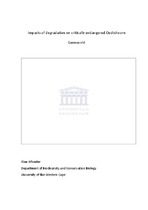| dc.description.abstract | In the Succulent Karoo biome of South Africa vegetation degradation by overgrazing is a recognized threat to biodiversity. In the eastern Little Karoo region of the Western Cape Province, ostrich farming has degraded large areas of natural vegetation, particularly in the Gannaveld habitat of the Oudtshoorn basin. Little quantified vegetation data exists on the impacts of degradation and the composition of the Gannaveld vegetation types. This study quantifies the composition of Oudtshoorn Gannaveld and the impacts of degradation on this critically endangered vegetation type. The diversity of this vegetation type is added to by the occurrence of mima-like circular soil mounds, termitaria, which support distinctive plant assemblages. Perennial plant data and soil data were collected from the largest remaining remnant of Oudtshoorn Gannaveld perceived to contain different levels of degradation from near pristine to severely degraded. The results show 72 species in 49 genera and 17 families were recorded with the Aizoaceae, Asteraceae and Amaranthaceae families being dominant. The off termitaria plant community is dominated by the Asteraceae, Aizoaceae and Crassulaceae families while the on termitaria community is dominated by the Asteraceae, Amaranthaceae and Zygophyllaceae families. Four levels of degradation were identified in each of the broader on and off termitaria communities. It was found that grazing and trampling induced degradation on termitaria results in the loss of perennial plant cover and plant litter and an increase in bare ground while degradation off termitaria results in a loss of species. There are changes in soil chemistry both on and off termitaria as a result of vegetation degradation. Degradation results in palatable species being replaced by unpalatable and disturbance indicating species. Perennial plant cover off termitaria is resilient to grazing and trampling, however species richness, plant functional type composition and the abundance of individual species are not. Species richness on termitaria is resilient to grazing and trampling but cover, plant functional type composition and the abundance of individual species are not. Degradation results in shifts from succulent and woody shrub dominated communities to dwarf succulent and dwarf succulent shrub dominated communities. These changes hold implications for agriculture,biodiversity conservation and the provision of ecosystem services. | en_US |

